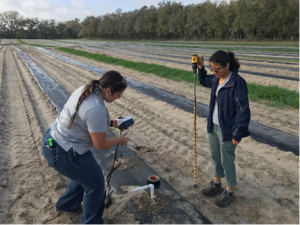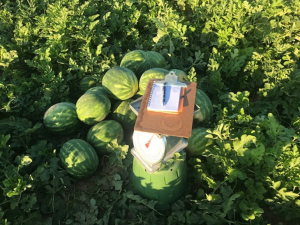A pilot project during the Spring 2023 growing season aimed to improve nitrogen use efficiency through new fertilizer technology. It also used the “4R’s” (Right source, Right rate, Right place, and Right time) as well as irrigation management. The goal was to introduce controlled-release fertilizer (CRF) on active watermelon farms and determine the pros and cons of using it from a grower’s perspective. The project also helped identify ways that growers can potentially reduce their nitrogen rates using CRF. The project included funding for a demonstration project for using CRF on 7 watermelon farms.
UF/IFAS led this on-farm research and Extension demonstration with funding support from the Suwannee River Water Management District and the Florida Department of Agriculture and Consumer Services Office of Agricultural Water Policy. Collaborators were industry reps including Harrell’s Fertilizer, Pursell Agri-Tech, Mayo Fertilizer, Waters Agricultural Labs, and cooperating Suwannee Valley region farms. Each grower compared their conventional fertilizer program to a CRF program on one of their farms.

Monday, April 10th, 2023, the “Twilight On-Farm Watermelon Field Day” took place at Whitehurst Cattle Company in Williston, Florida. On this field day, the UF/IFAS Suwannee Valley Watermelon Extension Team presented the 2023 Controlled Release Fertilizer Project to the attendees. Those attending included growers, industry professionals, UF/IFAS staff, and other interested individuals. Along with the CRF Project, attendees also received updates on Irrigation Automation and Watermelon Grafting Projects. It was a wonderful time for learning and fellowship over dinner provided by industry sponsors.
In addition to this field day, the UF/IFAS Suwannee Valley Watermelon Extension Team was able to present some of the results of this demonstration including yield and total nitrogen inputs as well as tissue and petiole-sap data at the 2023 Suwannee Valley Watermelon Institute Meeting in Fanning Springs, Florida. This event was held on November 30, 2023. The 183 total attendees heard educational presentations and built relationships with various industry representatives. Most recently, a poster on this project was displayed at the Southeast Regional Fruit and Vegetable Conference in Savannah, Georgia on January 11-14, 2024. This is the largest educational conference and tradeshow in the southeastern United States. Thousands of agriculturalists including growers, vendors, company representatives, educational professionals, and university extension faculty attended the conference.
Treatments

This demonstration compared the implementation of a conventional fertilizer program typically used by the grower, to a controlled release fertilizer program. Farmers chose a CRF program that would provide either the full season fertilizer needs or a portion of the total fertilizer needs for the season to be followed by fertigation events. In the second case, the grower would reserve a portion of the planned nitrogen rate to apply when sufficiency ranges began to drop but before deficiencies were noted based on weekly tissue testing (whole leaf or petiole-sap). Of the 7 growers:
- 2 growers decided to use a partial-season CRF program
- 4 growers implemented a full-season CRF program
- 1 grower chose to demonstrate both a partial-season CRF program and a full-season CRF program
All growers compared the CRF program they chose to their traditional conventional fertilizer program.
Results

(Photo provided)
Throughout the season, the research team collected and compiled data for each farm’s comparative demonstration. After summarizing the data, we developed tables and graphs which we presented to each grower. The collected data included season-long soil moisture sensor readings, season-long soil electrical conductivity readings, all nitrogen fertilizer applications, leaf tissue analysis, petiole-sap testing results, and yields which were taken at each harvest. In addition, at the end of the season, Extension agents Mark Warren and Tatiana Sanchez-Jones, along with Levy County Extension summer intern Kaley Tamanini, interviewed each farmer to gain a full perspective on the overall project. The major lessons learned throughout this project are listed below:
- While there were observable differences between products and programs, CRF products can yield comparable results to conventional programs.
- Based on grower feedback, CRF offers many potential benefits, including time and labor savings, convenience, nutrient conservation, and environmental stewardship!
- Regardless of the fertilizer source, irrigation management is a critical factor.
- CRF programs must be carefully aligned with producer goals concerning release curves, fertilizer placement, and injection requirements.
- In addition to precise irrigation management, soil moisture sensors can provide valuable insight into fertilizer movement and availability.
Overall, this 2023 CRF Demonstration project was a great success and we learned much throughout the season. As hoped, some participating growers have expressed their interest in continuing to incorporate controlled-release fertilizer programs into their growing operations as a means to improve nitrogen-use efficiency!
Mark Warren, Tatiana Sanchez-Jones, and Tyler Pittman contributed to this blog article. Mike Loizzo formatted the article for the blog and published it.
Source: UF/IFAS Pest Alert
Note: All images and contents are the property of UF/IFAS.



